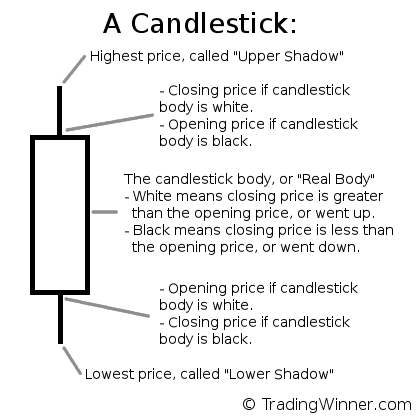I have made a simple tutorial for people unfamiliar with candlestick charts and candlestick trading techniques. I primarily use candlestick charts whenever I view stock charts. The benefits of candlesticks are numerous.
What are candlesticks?
Candlesticks are a gift from Japanese rice traders. The traders developed them to predict future rice demand, in order to take full advantage of the fluctuation of rice prices. The rice traders wanted to buy low and sell high, which is our same goal.
The picture below outlines the major characteristics of candlesticks.

Each candlestick represents 4 pieces of data:
- The opening price at the start of the trading session.
- The closing price at the end of the trading day.
- The day’s high price.
- The day’s low price.
Candlesticks also show if the price went up (white candlestick body) or down (black candlestick body).
Some candlesticks have long bodies and others have very short bodies and look like a cross. The size of the body means a lot in candlestick trading. Candlestick patterns and various candlestick trading strategies use the size of candlestick bodies to determine when you should buy and when you should sell. Those topics are for a later date.
My belief is that using candlesticks, with 4 pieces of stock price information and many useful patterns and strategies, gives me a trading advatange.